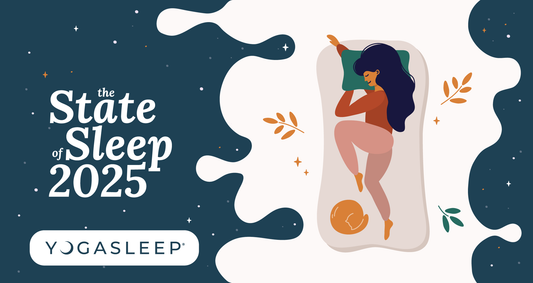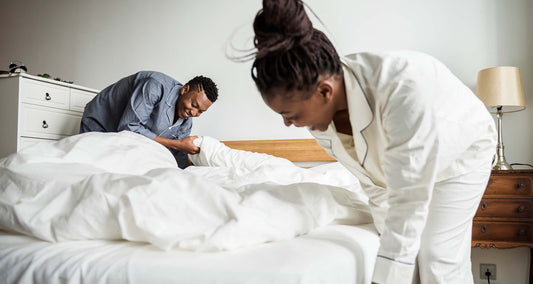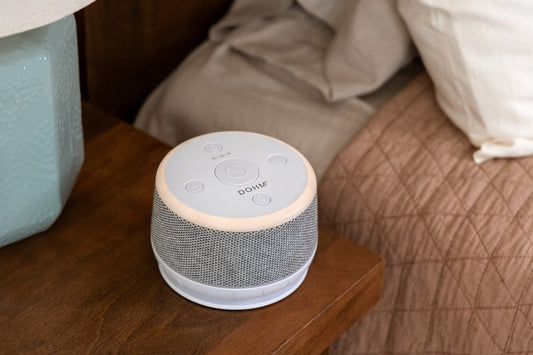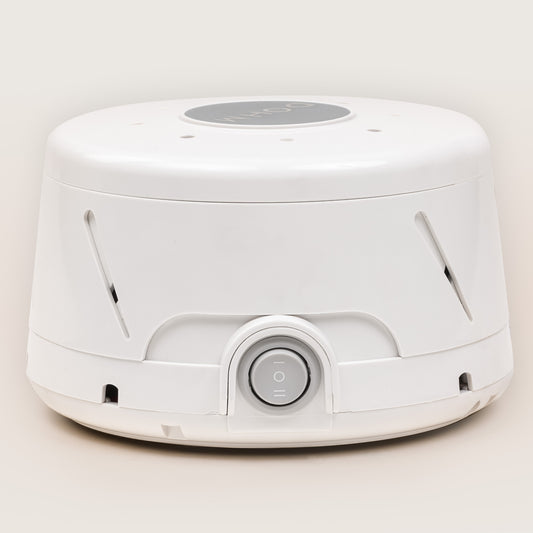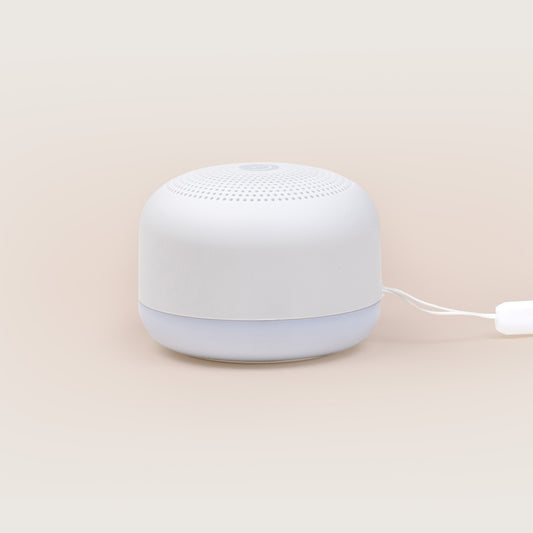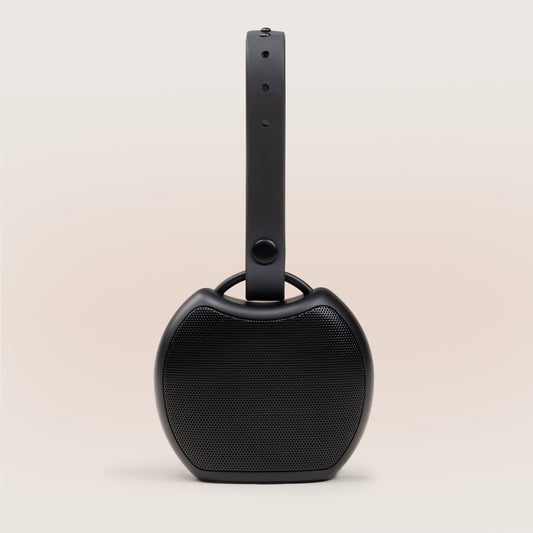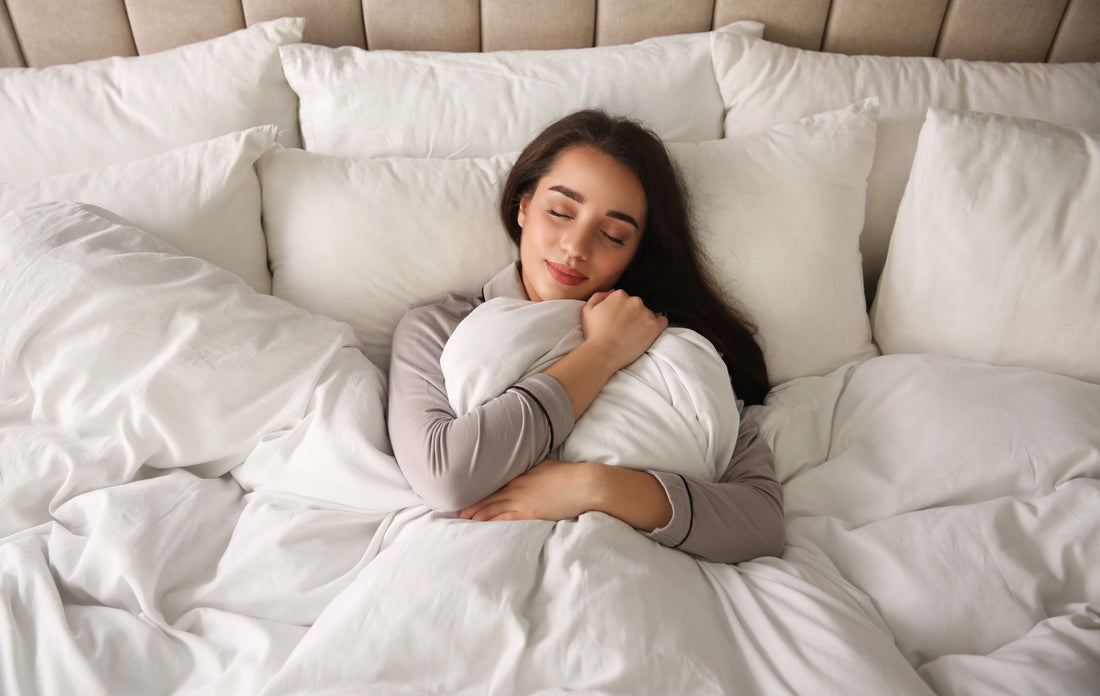
35 Ways to Fall Asleep and Stay Asleep
Whether you're a busy millennial juggling work and wellness, or a superhero mom navigating the challenges of parenthood, we understand how elusive a good night's sleep can sometimes feel. But here’s the good news: we've compiled 35 ways to help you fall asleep and stay asleep—and they’re all backed by science.
1. Catch Some Rays
Preparing yourself for a good night’s sleep starts long before bedtime. Make sure you get a good amount of exposure to sunlight during the day, which helps your body’s circadian rhythm cycle better. When your internal body clock is functioning correctly, it’s easier for you to fall asleep when it's time to hit the hay.
2. Get Moving
Getting your blood pumping and your heart rate up during the day also helps regulate your body clock and can improve the quality of sleep by boosting serotonin (the happy hormone) and decreasing cortisol (the stress hormone).
3. Limit Caffeine and Alcohol
It seems pretty obvious to avoid caffeine right before bed, but experts say if you’re having trouble falling asleep, you might want to lay off the coffee and energy drinks up to six hours before bed.
Having an alcoholic beverage or two before sleep might make you feel more tired and relaxed, but studies show that alcohol can negatively impact your quality of sleep.
4. Check Your Munch Times
We know late-night snacking can be tempting, but try to eat your last meal at least 4 hours before bed. Also, take your daily food choices into consideration. Eating spicy food for dinner or eating right before lying down can trigger acid reflux or heartburn, making it much harder to drift off.
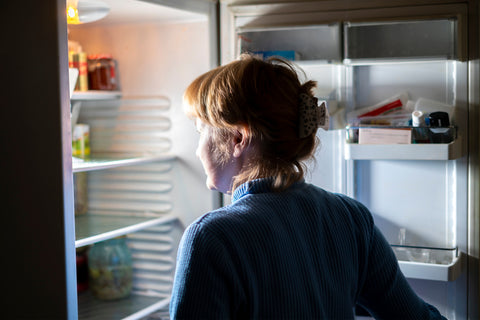
5. Avoid the Cat Nap
If you’re struggling to fall asleep at night, avoid taking naps during the day. It can become a vicious cycle: you struggle to fall asleep one night, so you take a nap the next day, which makes it harder to fall asleep that night, and repeat. Some studies have shown that regular naps over 2 hours can lead to poor sleep quality at night. Napping during the day also uses up your sleep drive, which can make it more difficult to fall asleep at bedtime.
6. Create a Bedtime Routine
Establishing a consistent bedtime routine helps set your circadian rhythm so your body knows when it’s time to rest. Practicing good sleep hygiene can go a long way in making bedtime less stressful. Start winding down about an hour before your actual sleep time, to help your body relax and prepare for dreamland. Try incorporating some of our other tips, like soothing sounds, dim lights, reading, or stretching to really set the mood for a peaceful snooze.
7. Make Your Bed a Sanctuary
Make your bed an inviting place of restful, rejuvenating sleep. Snuggle up with your favorite pillows, leave phones and computers out of the bedroom, and restrict wind-down activities to solely sleeping to enhance the association between your bed and snoozing. Creating this mental association is one aspect of practicing good sleep hygiene, and can also improve your sleep efficiency.
8. Lower the Temperature & Get Cozy
If you can, set the thermostat between 60 and 67 degrees and make sure you have layers of bedding to create a cozy vibe. Your body’s temperature drops during sleep, so while these lower temps might sound cold during the day, they’re actually perfect for getting some deep ZZZs.
9. Check Your Mattress
Set yourself up for sleep success by making sure your mattress is comfortable, supportive, and suited to your sleeping position. If you tend to sleep warm, consider looking into a cooling mattress. They help wick heat (and even sweat) away from your body and promote good airflow, keeping your body at an optimal sleeping temperature.
10. Take a Hot Bath
A hot bath or shower is a perfect way to unwind after a hard day. In fact, it’s been proven to help you fall asleep 36% faster. Just make sure to take at least a 10 minute soak about 90 minutes before bed, or your body might not have enough time to cool down, and your hot bath could end up keeping you awake due to overheating.
11. Ditch the Blue Light
Blue light is scientifically shown to suppress melatonin, the hormone your body produces that encourages you to sleep. Watching tv, browsing the internet, or checking social media on your phone are all ways you may be bringing pesky blue light into the bedroom, thus making it harder for you to get refreshing rest. Putting away your screens an hour before bed can drastically improve your quality of sleep.
12. Try Soothing Sounds
You don’t have to ditch tech completely to get a good snooze. Try winding down with relaxing noises, like pink or white noise, rainfall, or crashing ocean waves. A A sound machine is a perfect way to listen to your perfect nighttime soundtrack while actually improving your sleep by blocking out disruptive noises.
If nature noises aren’t your thing, you can always use a a sound machine with a wireless speaker and play your favorite calming songs, podcast, or audiobook before bed.
13. Dim the Lights
Set the mood (for sleeping, silly!) by dimming the lights and creating a relaxing, amber glow. Bright lights, like blue light, keep you awake, but soft, yellow-toned lighting is a gentler way to relax without sitting in complete darkness.
Some sound machines also include a night light for two-in-one relaxation features and less bedside clutter. If any amount of light creeping into your eyes disrupts your sleep, try an eye mask for complete darkness.
14. Put On Comfy Jammies
Put on your favorite pjs and make sure they aren’t restrictive or sweaty. The fabric you sleep in can have a strong impact on your sleep quality and ability to stay asleep. Materials like cotton and bamboo can help you stay cool throughout the night.
15. Get Bendy
Try some relaxing yoga to put your mind at ease and relax your muscles. A 2013 study showed that people who did yoga saw an improvement in sleep quality and insomnia. Stretching is a great way to ease the tension in your body and prepare you for a good night’s rest.
16. Experiment with Meditation & Mindfulness
Meditation is a great way to overcome insomnia.. When you meditate before bed, you release any built-up tension and stress and focus solely on the present moment. You can try a meditation or mindfulness app, podcast or Youtube video, or follow these simple steps:
- Get into a comfortable position
- Close your eyes and focus on deep breaths, in and out
- Push all thoughts from your mind. If you feel any thought creeping in, refocus your breathing
- Try to start with 5 minutes of meditation, and gradually work your way up
17. Stick Your Nose in a Book
Reading is a low-effort activity that gives your brain something to do while also allowing it to relax. Make sure you’re not using an e-reader that emits blue light that can keep you awake – there are new settings (e.g. “Blue Shade”, or “Night Shift”) on these devices that claim to remove disruptive blue light. Otherwise, stick to a good old paperback, or even try an audiobook to give your eyes a rest. Some people even have their favorite “sleep book” – something that they’ve read before and isn’t exciting or overly stimulating (looking at you, A Tale of Two Cities.)
18. Write Out Your Thoughts
Getting your thoughts out of your mind and onto paper is a great way to unwind before bed. It can also help prevent racing thoughts once your head hits the pillow. As a bonus, try to fill your journal with positive thoughts, gratitude, or things you’re looking forward to. This puts you in a positive headspace, which can help you sleep better.
19. Try Aromatherapy
Using essential oils to create a relaxing bedroom ambiance can help improve your sleep quality. Try scents like lavender, damask rose, peppermint, lemon, or orange in an oil diffuser in your bedroom to help you drift off faster.
20. Drink a Soothing Beverage
Instead of reaching for a glass of wine or a warm caffeinated coffee, try relaxing your body with a soothing, decaffeinated bedtime beverage, like chamomile, passionflower,, or magnolia, which have all been shown to encourage sleep.
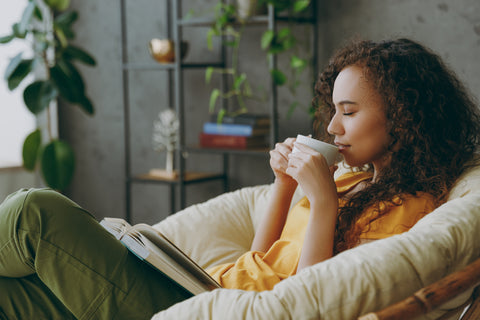
21. The Military Method
The military method is a calming technique that focuses on your breathing, mental imagery, and relaxation. To try the military method, simply follow these steps:
- Starting with your face, tense your muscles, and the allow them to relax naturally while taking deep breaths
- Repeat the process with your entire body, tensing and relaxing your chest, legs, arms, feet, etc.
- Clear your mind by imaging a relaxing image, like slowly rocking back and forth on a boat in a calm lake
- If you’re still awake, try repeating to yourself, “don’t think, don’t think” over and over for 10 seconds and then try again
22. Do a Body Scan
A body scan is a specific type of meditation involves focusing on each body part, one at a time, until you feel completely relaxed. It is similar to the military method, but with a body scan, you move very slowly — it should take about 10 to 20 minutes to reach your feet.
- Get into a comfortable position
- Start with your head. Focus on your head until it feels completely relaxed.
- Once your head is relaxed, move to your shoulders. Focus on them until they feel completely relaxed.
- Move down the right side of your body, relaxing each part as you go
- Once your right side is completely relaxed, move to the left side of your body
- Do this for 10 to 20 minutes, and repeat if necessary
23. Progressive Muscle Relaxation
Progressive muscle relaxation is similar to the body scan or the military method, except that you tighten certain muscle groups multiple times before letting them relax. The goal is to focus on the lack of tension in your body.
- Tighten your forehead muscles by raising your eyebrows. Allow them to relax, focusing on the release of tension from the temples
- Squeeze your eyes shut, and then relax them. Focus on the feeling of your eyelids falling over your eyes
- Smile until you feel tension in your jaw and cheeks. Relax your face, focusing on how each muscle feels
- Repeat the process with the rest of the muscles in your body, moving to your shoulders, arms, and down the rest of your body
- Focus on the feeling of relaxation until you fall asleep
24. 4-7-8 Method
The 4-7-8 breathing technique involves a specific pattern that helps your body and brain relax by forcing your mind to focus on your breathing. Follow these steps to try the 4-7-8 method:
- Get comfortable. Let your tongue relax behind your upper front teeth
- Slowly exhale completely through your mouth
- Close your mouth, breathe in through your nose for 4 seconds
- Hold your breath and count to 7
- Open your mouth and completely exhale while counting to 8
- Repeat this cycle at least 4 times
25. Autogenic Training
Autogenic training is based on the principles of hypnosis. Using verbal commands, you essentially “tell” your body to enter a deep state of relaxation. Here’s how to try out autogenic training:
- Lay down and focus on your breath, telling yourself, “I am completely calm”
- Focus on your arms, telling yourself, “My arms are heavy” and “I am completely calm,” repeating at least 6 times
- Focus on your legs, telling yourself, “My legs are very heavy” and “I am completely calm, at least 6 times
- Repeat these steps with different parts of your body, like your stomach, shoulders, and feet. Say the above phrases to yourself at least 6 times
- Once you feel relaxed, bring you attention to your whole body, which should reel completely relaxed
- Repeat the above steps until you have fallen asleep
26. Paint a Picture (In Your Mind)
Imagery is a calming technique you can do before bed to help you relax and unwind. Simply image a peaceful, happy thought and try to “paint” that picture in your mind — right down to the tiniest detail. Science has shown that imagery can help you get to sleep faster.
27. Reverse Psychology
You may have found that trying to compel yourself to fall asleep just doesn’t work. Instead of trying to force yourself to get some shuteye, try forcing yourself to stay awake. The theory is that trying to make yourself to fall asleep can cause stress and anxiety that may prevent you from getting those ZZZs. Some studies have shown that this technique helps people with insomnia fall asleep.
28. Grab a Pair of Socks
While your body does benefit from a lower sleep temperature, having cold feet (literally) can make it harder to sleep. Throwing on a pair of socks before jumping into bed can help the blood vessels in your feet dilate, which lets your brain know that it’s time to snooze.
29. Turn Off the Clock
Staring at the clock, watching the time go by, and wishing you were asleep doesn’t really do you any favors. In fact, it can actually raise your stress levels, making it harder to fall asleep. Try facing the clock towards the wall, or even unplugging it completely (if you don’t need your alarm) to relieve some of the pressure of the night moving forward without you getting your rest.
30. Adjust Your Sleep Position
Many experts agree that sleeping on your side is the best position for rejuvenating rest. However, it may not be the best for you, your body, and your health problems. Try rotating positions, like laying on your back, stomach, and side, and see what works best for you.
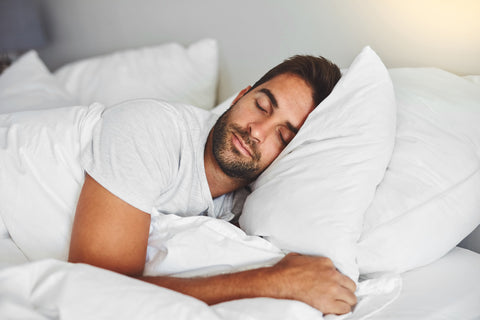
31. Try a Weighted Blanket
Weighted blankets are essentially, well, heavy blankets. They’re known for their comforting effects and can provide relief from stress and anxiety by providing deep pressure therapy. Ideally, your weighted blanket should be around 10% of your body weight. This lets you get the deep pressure benefits without feeling too claustrophobic or restricted. Check out this blog post to learn more about weighted blankets.
32. Schedule Your Sleep
Your body has a natural internal sleep clock: your circadian rhythm. It functions best on a schedule, so try to stay consistent with your sleep times, which should make both falling asleep and waking up for the day easier. Make sure to give yourself 30 minutes to an hour to wind down before your actual sleep time, as this makes it easier to fall asleep when you finally rest your head on your pillow.
33. Wait Until You’re Sleepy
Don’t jump into bed just because it’s 11pm. If you’re not tired, try doing some relaxing or mundane tasks until you actually feel like you can fall asleep. This can help prevent the dreaded tossing and turning, racing thoughts, and staring at the ceiling. It also keeps your mind from associating being in bed with being awake.
34. Tap On Your Legs
Jim Donovan, a “sound healer” also known for being the drummer of the band Rusted Root, shared this unique method for getting to sleep. To try this technique, gently tap on your legs, alternating between each of them, to mimic the comforting rhythm of a ticking stopwatch—about 4 taps per second. four taps per second. While tapping, focus on mindful breathing, inhaling and exhaling slowly while counting to 4. This practice leverages the brain’s natural affinity for rhythm to usher in a state of relaxation.
35. Get Up
The worst thing to do when you just can’t sleep is to stay in bed, tossing and turning for hours. If you really can’t drift off to dreamland, try getting out of bed and doing a simple, mundane task, like reading or knitting, until you’re actually sleepy. Getting out of bed prevents your brain from creating a mental connection between your bed and being awake, which can make it harder to fall asleep in the future.
Falling asleep can be a frustrating task, but with some habit changes and a few tips and tricks, it can be easier than counting sheep.
Disclaimer: The information on our site is NOT medical advice for any specific person or condition. It is only meant as general information. If you have any medical questions and concerns about you or your family’s sleep, please contact your health provider.

